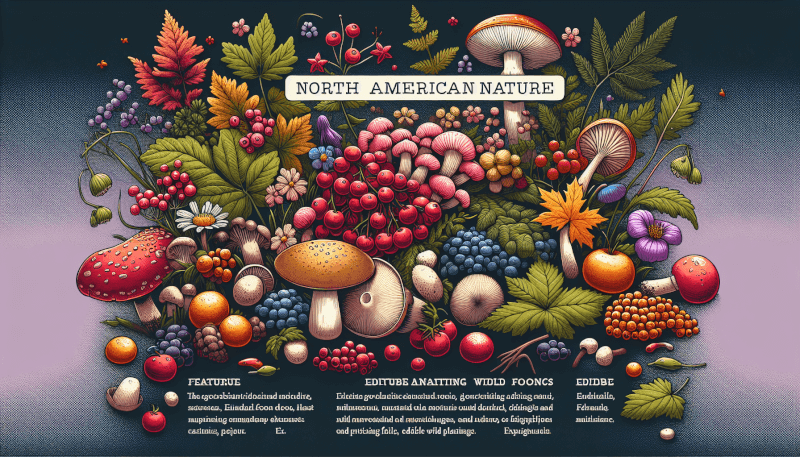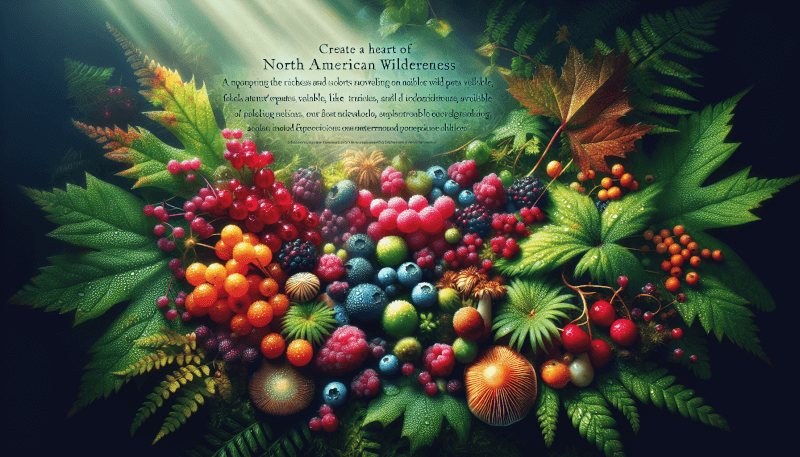Are you ready to embark on a culinary adventure through the untamed landscapes of North America? Look no further than “Edible Wild Plants: A North American Field Guide To Over 200 Natural Foods.” This comprehensive guide is your passport to discovering a world of delectable flavors hiding in plain sight. From the thriving forests to the vast meadows, this guide will introduce you to a bountiful array of wild plants that can be safely consumed, transforming your outdoor explorations into unforgettable feasts. With stunning photographs and detailed descriptions, this field guide is the ultimate companion for nature enthusiasts and aspiring foragers alike. Get ready to unlock the rich tapestry of edible wild plants that our continent has to offer.

Introduction
Welcome to the world of edible wild plants! In this comprehensive guide, we will explore everything you need to know about finding, identifying, and preparing edible plants that can be found in North America. Whether you are a foraging beginner or a culinary enthusiast, this article will provide you with valuable information on how to safely and responsibly enjoy the abundance of nature’s pantry.
Understanding Edible Wild Plants
Benefits of Edible Wild Plants
Edible wild plants offer numerous benefits, both for our health and the environment. By incorporating these plants into our diets, we can diversify our nutrition and enjoy a wide range of flavors. Additionally, foraging for wild food allows us to connect with nature on a deeper level and develop a greater appreciation for the world around us.
Nutritional Value of Edible Wild Plants
Edible wild plants are a rich source of nutrients, often offering higher levels of vitamins, minerals, and antioxidants than cultivated crops. These plants can provide essential vitamins such as vitamin C, vitamin A, and vitamin K, as well as minerals like calcium, iron, and potassium. Including a variety of wild plants in our diets can contribute to overall health and well-being.
Ethical Foraging Practices
When foraging for edible wild plants, it is important to practice ethical harvesting techniques. This includes only taking what you need, respecting the habitats of these plants, and avoiding endangered or protected species. By following these guidelines, we can ensure the preservation and sustainability of wild plant populations for future generations.

Finding and Identifying Edible Plants
Common Foraging Tools
Before venturing out into the wild, it is important to gather the necessary tools for successful foraging. Some common tools include a field guidebook on edible plants, a knife or pruners for harvesting, a basket or bag for collecting, and a magnifying glass or hand lens for detailed plant identification.
Basic Plant Identification
Identifying edible plants can be an exciting challenge. Begin by familiarizing yourself with the key characteristics of different plant families and species. Pay close attention to features such as leaf shape, flower color, stem structure, and growth habit. It is also helpful to learn about the specific plant species that are abundant in your region.
Key Features to Look For
When identifying edible wild plants, there are certain key features to look for. This includes the shape and arrangement of leaves, the presence of distinctive flowers or fruits, the texture and color of plant parts, and any unique smell or taste characteristics. By honing your observational skills, you can become more proficient in identifying edible plants.
Poisonous Look-Alikes to Avoid
While there are many edible plants in the wild, there are also poisonous look-alikes that must be avoided. It is crucial to be able to distinguish between edible plants and their toxic counterparts. Some common examples include the deadly nightshade, which resembles edible berries, and poison hemlock, which looks similar to wild carrots. Always double-check your plant identification and consult a reliable source to ensure safety.
Preparing Edible Wild Plants
Cleaning and Washing Techniques
Before preparing edible wild plants, it is important to clean and wash them properly. Remove any dirt, insects, or damaged parts by gently rinsing the plants under cool water. Be thorough but gentle to preserve the delicate flavor and texture of the plants.
Edible Plant Preparation Methods
There are various ways to prepare edible wild plants, depending on their characteristics and individual tastes. Some common preparation methods include blanching, sautéing, steaming, stir-frying, or incorporating them into salads or soups. Experimenting with different cooking techniques will help you discover the flavors and textures that you enjoy the most.
Cooking and Recipes
Cooking with edible wild plants allows for endless culinary possibilities. Incorporate wild greens into your favorite salad recipes, add edible flowers to your baking creations, or use wild fruits as a unique topping for your morning pancakes. Get creative in the kitchen and explore the flavors of nature’s bounty.

Safety Precautions
General Safety Guidelines
When foraging and consuming edible wild plants, it is essential to prioritize safety. Here are some general safety guidelines to follow:
- Always positively identify plants before consuming them.
- Avoid foraging near roadsides or areas with potential pollution.
- Be cautious of plants growing in contaminated soil or near agricultural fields.
- Avoid harvesting plants from areas sprayed with pesticides or herbicides.
- Only consume plants that are in healthy condition and free from signs of disease or damage.
Allergies and Sensitivities
Just like with any food, some individuals may have allergies or sensitivities to certain wild plants. If you are unsure whether you may react negatively to a specific plant, it is recommended to start with a small portion and monitor your body’s response. If any allergic reactions or discomfort occur, discontinue consumption and seek medical advice.
Toxic Plant Interactions
Certain edible wild plants may have toxic interactions with medications, alcohol, or other substances. It is crucial to do thorough research or consult a healthcare professional if you are currently taking medications or have preexisting health conditions. Safety should always be the top priority when it comes to consuming wild plants.
Edible Plants by Habitat
Plants in Forests and Woodlands
Forests and woodlands are rich habitats for edible plants. Some common examples include ramps, morels, wild berries, and edible mushrooms. Take a walk through the forest and discover the delicious treasures that await you.
Plants in Meadows and Fields
Meadows and fields provide a diverse array of edible plants. Look for wild greens such as dandelion leaves, lamb’s quarters, or chicory. Additionally, meadows often offer colorful edible flowers such as violets or clovers, which can add beauty and flavor to your meals.
Plants in Wetlands and Marshes
Wetlands and marshes are home to unique edible plants that have adapted to thrive in these water-rich environments. Some examples include cattails, watercress, and water lilies. These plants offer a refreshing and nutritious addition to your foraged ingredients.
Plants in Mountains and Alpine Areas
Mountainous regions and alpine areas are known for their hardy edible plants. Look for mountain sorrel, fireweed shoots, or Alpine blueberries. These plants have adapted to survive in harsh conditions, resulting in unique and flavorful culinary possibilities.

Edible Plants by Season
Spring Edible Plants
Spring is a bountiful season for foragers. Some edible plants that emerge during this time include fiddlehead ferns, wild leeks, and ramps. The fresh and vibrant flavors of these spring delicacies are not to be missed.
Summer Edible Plants
Summer brings an abundance of edible plants that thrive in the warmth of the sun. Look for wild berries such as blackberries, raspberries, or blueberries. Nourishing greens like purslane, plantain, and lamb’s quarters are also plentiful during this season.
Fall Edible Plants
As the leaves change color, a new wave of edible plants emerges. Nuts such as acorns and hickory are ready for harvest, along with wild mushrooms like chanterelles and morels. Don’t forget to enjoy the culinary delights that the fall season has to offer.
Winter Edible Plants
While winter may seem less fruitful, there are still edible plants to be found even in colder climates. Look for wintergreen, rose hips, and certain types of mushrooms that can withstand the winter chill. These hardy plants bring a taste of nature to the colder months.
Edible Plants by Region
Northeastern United States
The northeastern United States offers a wealth of edible plants. Look for beach plums along the coast, ramps in forests, or elderberries in wetland areas. The diverse landscape of this region provides numerous opportunities for foraging.
Southeastern United States
The southeastern United States is home to many edible plants with a rich culinary history. Look for pawpaws in the forests, watercress near streams, or mayhaw berries in marshy areas. The flavors of the Southeast are waiting to be discovered.
Midwestern United States
The Midwest boasts its fair share of edible plants. Morels often emerge in the spring, while gooseberries and juneberries are abundant in the summer. Explore the prairies, woodlands, and fields of the Midwest to uncover the edible treasures they hold.
Southwestern United States
The arid landscapes of the southwestern United States offer unique edible plants that have adapted to thrive in these conditions. Prickly pears, mesquite pods, and desert-tolerant greens like amaranth can be found in this region. Embrace the flavors of the desert and discover a new world of culinary possibilities.
Western United States
The western United States is home to a vast array of edible plants. Forage for huckleberries in the mountains, wild onions in meadows, or black elderberries near rivers. This diverse region promises a never-ending adventure for foraging enthusiasts.
Northern Canada
The northern regions of Canada may be challenging for foragers due to the harsh climates, but there are still edible plants to be found. Arctic raspberry, Labrador tea, and cloudberries are just a few examples of the unique plants that thrive in this rugged environment.
Southern Canada
The southern regions of Canada provide a more forgiving climate for foragers. Look for fiddlehead ferns in the spring, Saskatoon berries in the summer, or wild hazelnuts in the fall. The Canadian wilderness has a bounty of delicious plants to offer.
Pacific Northwest
The Pacific Northwest is renowned for its abundant edible plants. From the iconic salmonberry to foraged seaweed, this region offers a diverse range of flavors that reflect its coastal and forested landscapes. Enjoy the culinary delights of the Pacific Northwest year-round.
Alaska
Alaska is a wild forager’s paradise, with its untouched landscapes and rich biodiversity. Look for sourdock greens, lingonberries, or beach greens along the coastline. The remote wilderness of Alaska is a treasure trove of edible plants waiting to be explored.
Mexico
Mexico is a land of culinary richness, with its diverse flora offering a myriad of edible plants. From nopales (cactus pads) to Moringa leaves, or the vibrant flavors of achiote seeds, the traditional flavors of Mexico can be found in its edible wild plants. Immerse yourself in the colorful tapestry of Mexican cuisine.

Conclusion
Foraging for edible wild plants is a rewarding and enriching experience. It allows us to connect with nature, diversify our diets, and explore the flavors of the land. By understanding the benefits, nutritional value, and safety precautions associated with edible wild plants, we can embark on a journey of culinary exploration and appreciation for the natural world around us. So grab your foraging tools and immerse yourself in the wonders of edible wild plants – a North American field guide to over 200 natural foods awaits you.


